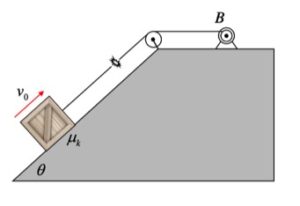| Problem statement Solution video |
DISCUSSION THREAD

Any questions?? Please ask/answer questions regarding this homework problem through the "Leave a Comment" link above.
| Problem statement Solution video |
DISCUSSION THREAD

Any questions?? Please ask/answer questions regarding this homework problem through the "Leave a Comment" link above.
Comments are closed.
Are we safe to assume gravity is = 9.81 m/s^2? Or would it be better to leave our answer in terms of g because it isn't given?
Either way is fine. Since everything else is left in terms of symbols, leaving it as "g" would make sense.
For this problem I found it is important to check and see when the block starts to travel downwards. This is critical because if the friction force will flip direction when it travels downwards. If it flips direction during the time frame given then it could divide the problem into two parts.
What process should we use to find the time where it flips?
What process would you use to find the time before the block stops and therefore the friction would flip direction?
You can solve for the time when the block could stop moving or flip directions with the impulse momentum equation you'll need for the rest of the question. If you set v = 0, and solve for delta t, that will give the time when the block stops or flips directions.
For the right hand on the impulse equation only takes into account external forces, would that just be zero and the momentum is conserved, or would we consider friction force to be external in this case?
When you draw an FBD of the crate, the friction force will appear. Therefore, any linear momentum equation coming from that FBD will need to have the impulse due to the friction.
This problem is pretty straightforward if you take into account which external forces are acting on the block using an FBD and then using the linear momentum equation to plug in and simplify the equation.
are there going to be two separate impluse intergrals since the friction could change directions?
You are only concerned with what happens the instant the cord snaps. Meaning that the box still has speed moving up the hill, and friction will oppose this upward motion.
I don't think that this problem could be solved if the block did change directions because we don't know the coefficient of static friction.
Since all variable that lead to solving for the force in the direction parallel to the ramp are constant we can conclude the force in this direction is constant (assuming the change in g is negligible, as should be in this case). With this the integral in the momentum equation is very easy to solve and can actual be skipped entirely by knowing change in momentum from a constant force is simply that force times the change time.
Would it be beneficial to set our coordinate system to have the x-axis in line with the incline?
That would be a good idea.
I did this when solving and I felt it helped me to keep track of when moments were added vs when they were subtracted.
Be sure to check the direction of velocity at T=1.5 before solving.
As always, I think the best approach is to solve this problem in terms of variables first, then plug in values. After doing this you'll find that the answer is not actually dependent on the mass of the block!
This problem can be tricky for some: When the cable snaps, the box starts moving backwards and we're left to think that friction force goes in the +X direction. Nonetheless, after the cable snaps we still consider the velocity of the box to keep moving +X direction, thus our friction force is in the -X direction. As a quick side note, remember to properly label you plane, as this can make the problem significantly easier to understand and solve.
I think it's important to draw out the FBD to find the correct direction for the forces acting on the block once the line breaks. This can then be plugged into the impulse-momentum equation to get the final velocity of the block.
For this problem, I first solved for when the crate will come to rest after the cable snaps. I used the result to determine what direction the crate will be traveling in to then solve for the speed at delta t.
Problem 4C1 (Page 236) was useful to look at if stuck, except notice that there is a difference of the ∑Fx looking at the FBD since there is no Force applied and the block is at an incline.